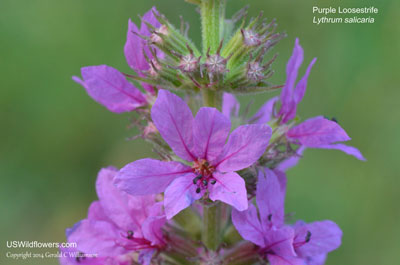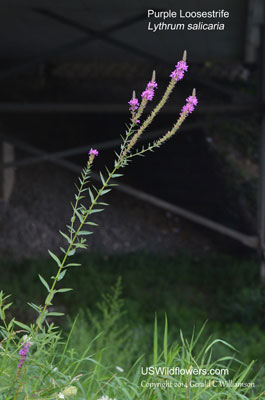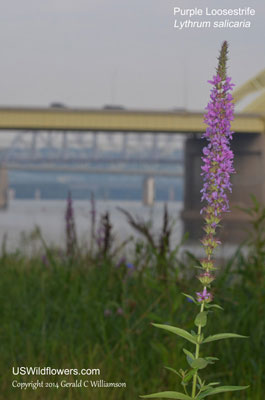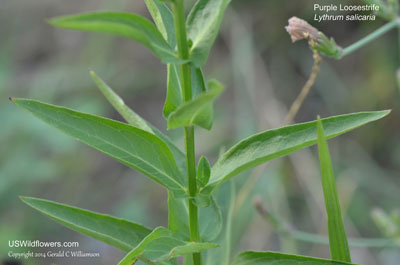Purple Loosestrife, Rosy Strife, Kill Weed - Lythrum salicaria
|
Lythrum salicaria - Purple Loosestrife, Rosy Strife, Kill Weed. Lythrum is a fairly small genus with about 36 species worldwide, with 13 species found in the United States, only 6 of which are native.
The species presented here, Lythrum salicaria, Purple Loosestrife, is the most widely distributed species, and it is not a native. Introduced as an ornamental from Eurasia in the 1800s, this is a highly invasive (but, unfortunately, attractive) weed, especially in northeastern parts of the United States. It is found in damp grasslands and banks of rivers and streams in every state except Florida, according to the U.S. Fish and Wildlife Service, and is a threat to wetlands in all of them. It is prohibited in at least 33 states - DO NOT CULTIVATE THIS PLANT even though it continues to be sold by some nurseries, claiming that the plants they are selling are sterile - they may be right, but they may be incorrect, and it is not worth the risk.
Found in:
AK, AL, AR, CA, CO, CT, DC, DE, GA, HI, IA, ID, IL, IN, KS, KY, LA, MA, MD, ME, MI, MN, MO, MS, MT, NC, ND, NE, NH, NJ, NM, NV, NY, OH, OK, OR, PA, RI, SC, SD, TN, TX, UT, VA, VT, WA, WI, WV, WY
Leave comments on Lythrum salicaria at this link. | 
Distribution of Lythrum salicaria in the United States and Canada:

Blue=Native; Grey=Introduced
Map from USDA Plants Database:
USDA, NRCS. 2017. The PLANTS Database (http://plants.usda.gov, 08 May 2025). National Plant Data Team, Greensboro, NC 27401-4901 USA.
Search Our Database: Enter any portion of the Scientific, Common Name, or both.
Do a general Google search of the entire site:
#ad
 Follow USWildflowers on Twitter
#ad
| | Site: Newport, Campbell County, KY Date: 2014-August-05 | Photographer: Gerald C. Williamson
Nikon D7000
Tamron SP 90MM f/2.8 AF Macro | | The inflorescence of Lythrum salicaria is a dense, elongated, nearly cylindrical cluster of many pedicellate flowers terminating the stems. Most other Lythrum species found in North America have solitary or paired flowers. | | 
| | Site: Newport, Campbell County, KY Date: 2014-August-05 | Photographer: Gerald C Williamson
Nikon D7000 | | The flower of Purple Loosestrife has 6 reddish purple, somewhat wrinkled petals. It normally has 12 stamens, although only 6 dark anthers are obvious in this photo. The stamens are usually in two whorls of 6 each, with each whorl having a different length filament. The other six can be seen with orangish anthers surrounding the base of the pistil in this photo. | | Click on the photo for a larger image

| | Site: Newport, Campbell County, KY Date: 2014-August-05 | Photographer: Gerald C Williamson
Nikon D7000 | | Lythrum salicaria grows to 5 or 6 feet tall and may have several branches; in my limited experience they seem to branch primarily in the upper half of the plant. | | Click on the photo for a larger image

| | Site: Newport, Campbell County, KY Date: 2014-August-05 | Photographer: Gerald C Williamson
Nikon D7000 | | Purple Loosestrife is primarily a plant of wet grasslands and streambanks, here on the banks of the Ohio River looking downstream at several of the bridges between Cincinnati and the Newport / Covington, KY area. | | Click on the photo for a larger image

| | Site: Newport, Campbell County, KY Date: 2014-August-05 | Photographer: Gerald C Williamson
Nikon D7000 | | The leaves of Purple Loosestrife can be quite variable, both in shape and hairiness, although they are generally lanceolate and usually somewhat hairy. The leaves are usually opposite or in whorls of 3, although in the upper stem they may occasionally be alternate. They are clasping or sessile with rounded or truncate bases. The stem is 4-angled, usually downy, and based on this specimen may be somewhat winged. | | Click on the photo for a larger image

|
References used for identification and information:
|
|
| |
| #ad
|
|






